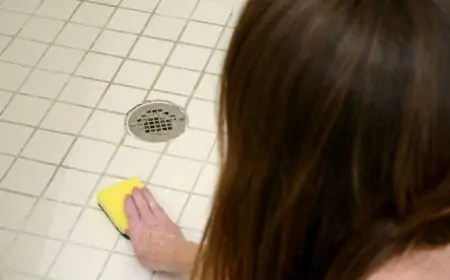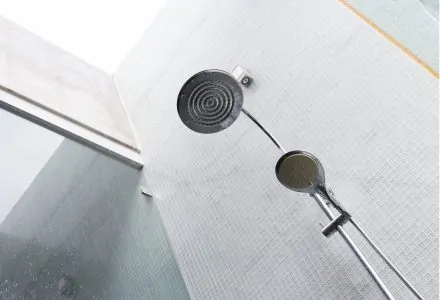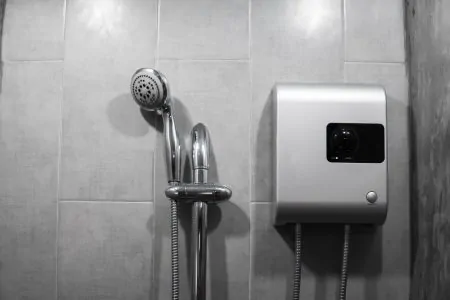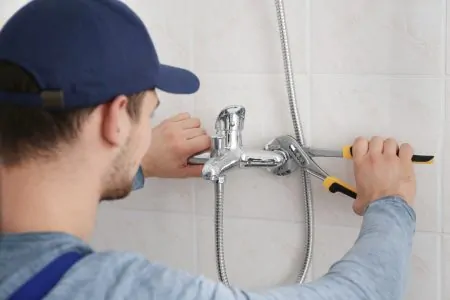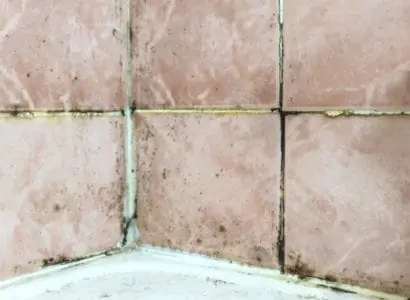Moisture is the ally of mold and mildew. Every time you shower, all that excess water and soap scum sits on the surface of your tiled shower enclosure, staining and creating the perfect environment for dirt and grime buildup.
Most people have some idea of how to clean shower tiles, but we show you the best way to clean shower tiles to leave them sparkling clean.
Key Takeaways
- Use a natural cleaning solution like white vinegar and water to remove mold and grime from shower tiles and grout.
- Baking soda mixed with water creates a thick paste that can effectively clean stubborn stains on shower tiles.
- Hydrogen peroxide, oxygen bleach, and chlorine bleach are powerful cleaning agents for removing tough stains from shower tiles and grout.
- To prevent mold and mildew growth, frequently clean your shower tiles, aerate the bathroom, and keep shower tiles dry after use.
How To Clean Shower Tiles
When all those unsightly stains become too much to bear, it’s time to do something about it. But what is the best method for cleaning shower tiles? Let’s take a look.
Vinegar
Vinegar is 100 percent natural and so useful as a cleaning product that every homeowner should keep a bottle handy. It’s cheap, widely available, and it covers so many areas of cleaning.
Mix 1-part of white vinegar with equal parts of water into a spray bottle and apply a generous amount to the surface of the tiles. Make sure the grout gets a good coating as well. White vinegar is better because it doesn’t leave any discoloration on the tiles of grout.
Leave the solution to sit for between 15 and 30 minutes. After the time has elapsed, grab a grout brush and start scrubbing at the stains and see them lift off. If you don’t own a grout brush, use an old toothbrush.
When you are done, spray the tiles with warm water to rinse off the vinegar solution. Grab a towel and dry the surface. If you want to keep mold at bay, it might be a good idea to apply one last coating of the vinegar and water mixture and leave it to sit on the tiles.
Can Vinegar Ruin Your Grout?
While neat vinegar is the ideal cleaning agent for tiles, it can damage grout, especially if it is unsealed and old. Grout consists of water, sand, and cement, and it starts to break down over time. If you have mold growth in the grout, it might be better to remove it completely and regrout to freshen up the shower enclosure.
The best solution is to water down the vinegar, so it still cleans but it doesn’t damage your grout.
Baking Soda
Baking soda is an ingredient most of us have in our kitchens, and it is completely natural, easy on the environment, and has a multitude of uses. So, how do you use it?
The first thing to mention is that you should wear gloves to protect your skin against adverse reactions should the baking soda make contact with your hands.
Mix the baking soda with a small amount of water to make a thick paste with the same consistency as toothpaste. Rub the baking soda onto the tiles and make sure the grout gets a generous covering too.
Leave the paste to sit for a few minutes while it gets to work on the mold and mildew. Next, use the vinegar and water spray and coat the paste. When the vinegar hits the baking soda, it starts to bubble.
Once the reaction subsides, grab a scrubbing brush and vigorously move the bristles over the stain, working in circular motions.
For the hard-to-reach areas, use a toothbrush. When you are satisfied that the soap scum is all gone, rinse the paste away with warm water. Now dry the surface of the tiles with a towel to remove excess moisture that could encourage mold spores to start growing again.
Hydrogen Peroxide
It may sound scary, but hydrogen peroxide is safe to use and environmentally friendly, and the good news is it’s available at almost every drugstore. That said, when using any type of chemical, it’s a great idea to don protective gloves.
Mix 1-part of hydrogen peroxide with 2 parts of water and apply it to the tile’s surface using a spray bottle. Leave it to sit for 30 minutes while it gets to work on your mold and mildew. You can always apply more hydrogen peroxide solution if you are struggling to get the stain to lift, even after the timescale has elapsed.
If you do this, leave it on the surface for a further 10 minutes. Now, grab a scrubbing brush and work the stained area in circular motions. As before, for the nooks and crevices, use a toothbrush for maximum effect.
If you want more punch to your cleaning product, mix the hydrogen peroxide with 2 parts of baking soda to form a thick paste. Smear it over the tiles and grout, and set your timer for 30 minutes.
After the time has passed, scrub at the affected area to remove the grime and rinse off the paste with warm water. Finally, pat the tile surface dry with a towel.
Oxygen Bleach
Oxygen bleach is not as common as standard bleach, but some manufacturers still make it in powdered form. It is an excellent product for shifting ground-in dirt, especially from grout.
Sprinkle 3 tablespoons of the oxygen bleach powder into 2 gallons of warm water. You will need a bucket for this. Mix the solution until the crystals dissolve. This should take about 30 seconds. Soak a cloth in the solution and smear it on your shower tiles, making sure that it soaks into the grout.
Now, wait for 15 to 20 minutes while the bleach works its magic, then rinse the surface clean with warm water. If you still have stains, don’t panic because there is another way to apply the bleach.
Mix the powder with a small amount of water to create a thick paste. Apply it to the affected area using a grout brush or a toothbrush, ensuring that the grout gets particular attention. When you have removed the stain, wash it clean with warm water and pat the tiles dry with a towel.
Chlorine Bleach
Chlorine bleach is the nuclear option when it comes to removing ground-in stains. However, wear gloves and a face mask when using this product because it gives off powerful odors. Also, make sure you open all the windows in the bathroom to let the air circulate.
Luckily, it is pretty easy to use. Pour the bleach into a spray bottle and apply it liberally to the tile and grout. Let it sit for approximately 10 minutes while the bleach reacts with the grime. While you can mix and match your cleaning solutions with the other methods, you can’t do that with bleach.
Don’t use vinegar because it reacts with the chlorine in the bleach to produce toxic gas. When you are satisfied with the results, rinse the bleach away with warm water and dry the tiles with a towel.
If you want to permanently keep mold and mildew at bay, keep a weaker solution of bleach and water in a spray bottle handy so that every time you use the shower, you can spray the tiles.
Steam Cleaner
A steam cleaner is a tile-friendly way to clean the grime off your shower surfaces. Using a grout-cleaning brush head means you can get into all the crevices between the tiles. Nylon brushes are better because they don’t damage the tiles or the grout.
Before steam cleaning, mop the tiles and use a mild detergent like dish soap to sponge-clean the loose dirt off the tile surface. This gives the steam cleaner a better chance of succeeding and stops larger debris from clogging the cleaner.
Ensure you have a model that works on both floor and wall tiles. As you work along the tile surface, stop now and again to rinse away the dirty water to prevent it from adhering to the tile surface.
When you have finished, rinse off the tiles with warm water and dry them with a towel.
Ammonia
Ammonia is pungent, so always open windows and doors and wear a respirator or face mask before using it. You can use ammonia in water or mix it with vinegar, or baking soda.
Add half a cup of baking soda to a third of a cup of ammonia. Next, pour in a quarter of a cup of vinegar and 7 cups of warm water and give it a good stir. Don’t mix ammonia with bleach because it produces toxic chlorine gas, which is harmful to your health.
Pour the solution into a spray bottle and apply a liberal coating to the surface of your tiles and grout. Let it sit for 5 to 10 minutes, and then scrub vigorously using a brush. Use an old toothbrush to get into the grout and other hard-to-reach areas.
When the grime is gone, wipe it down with a damp sponge and dry the surface of the tiles with a towel.
Top Tips on How To Keep Shower Tiles Clean
Wouldn’t it be amazing if you never had to scrub grime, soap scum, and mold from your tiles and grout ever again? Here are some tips to help keep your shower tiles clean and reduce the need for extensive deep cleaning.
Aerate the Bathroom
Bathrooms are damp spaces because of the high humidity levels created by steam. This is the perfect environment for mold spores to take hold because they feed on moisture. Allowing fresh air into the bathroom removes the humidity and reduces the chances of nasty fungal growth.
If you have a ceiling fan in your bathroom, keep it switched on for at least 15 minutes after you have left the room to replace the damp air with dry. The simplest way to combat moisture is to open the windows and let the fresh air in.
Run Hot Water
Running your shower on the hottest setting for 5 to 10 minutes helps lift away some staining, making it easier for you to get it clean. Do this just before you start cleaning, and it should speed up your task.
Keep a Bottle Handy
The easiest way to deter grime and mold growth is to keep a solution of vinegar and water in a spray bottle so that you can use it every time you have a shower. At the very least, spraying the shower once or twice a week works wonders at keeping dirt buildup at bay.
You can use vinegar, baking soda, bleach, and water, or ammonia and water. All are effective at cleaning tiles and grout. The key to success is the frequency with which you use these cleaning solutions and not waiting until the grime accumulates to the point you need to perform a deep clean.
Dry the Tiles
Removing moisture from the tile’s surface is the best way of stopping mold and mildew from taking hold. You can do this with a towel, or buy a window vacuum that sucks water to an onboard reservoir.
They are expensive, but they are fast and straightforward to use; plus, you don’t have damp towels to deal with. If you are using the towel technique, ensure that you remove it from the bathroom because it also encourages mold growth.
